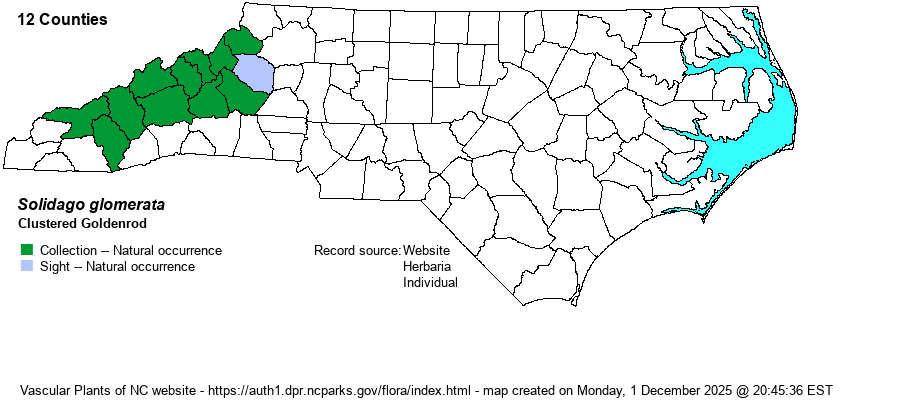| Author | Michaux | |
| Distribution | Mountains only, at high elevations. Specimens from the fen atop Bluff Mountain in Ashe County prove to be S. uliginosa: Mehrhoff 78108 (NCU) and Leonard 2057 (NCU); examined in 2020.
Endemic to eastern TN and western NC. Despite being found north to Watauga County, it is not yet known for VA. | |
| Abundance | Quite uncommon in most high elevation areas, but can be common to locally abundant on a few exposed high elevation peaks, such as Grandfather Mountain, Mount Mitchell, and Clingmans Dome. Populations usually also consist of many rosettes of non-flowering basal leaves. | |
| Habitat | Northern hardwood forests and openings, spruce-fir forests, rocky slopes and outcrops, exposed balds. It grows best in damp spots, such as seepages, at these high elevations. | |
| Phenology | Flowering and fruiting mid-August - October. | |
| Identification | Clustered Goldenrod grows 2-3 feet tall but is a quite robust plant. The basal and lower leaves are lance-shape to ovate, often reaching 6-8 inches long, the margins with small teeth, and the stem is winged. The inflorescence is composed of several heads in each of the upper leaves, plus a very dense terminal cluster that is elliptical in outline. In some plants the terminal cluster is much less dense. This can be one of the more numerous herbaceous plants in rocky openings at the summits of several high mountains, with longer and larger stem leaves than found on nearly all other similar goldenrods. | |
| Taxonomic Comments | None
| |
| Other Common Name(s) | Skunk Goldenrod | |
| State Rank | S3 | |
| Global Rank | G3 | |
| State Status | | |
| US Status | | |
| USACE-agcp | | |
| USACE-emp | FAC link |

